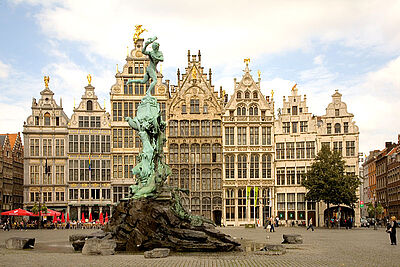A5 Searching for clues in Antwerp

First of all, the basic conditions in the 17th century were extremely advantageous. The maritime trade led the city to enormous wealth – a necessary background for the production of luxury goods of all kinds. In addition, the Catholic Flanders was a picture-loving region – supported in those times by the Counter-Reformation. However, while names as Peter Paul Rubens and Anthony van Dyck still have a good sound, it is much less known that in the Scheldt city, the best keyboard instruments of the world were produced - and delivered to the royal courts of Europe. Hans, Ioannes and Andreas Ruckers as well as Ioannes Couchet are appreciated by harpsichordists as Amati, Guarneri and Stradivari by the violinists. In this regard, Antwerp is comparable to Cremona. The high appreciation of the instruments can not least be read by the significant number of forgeries. As we know from the sources, keyboard instruments were often decorated with paintings. Here find names like: Otto van Veen, Peter Paul Rubens, Jan Brueghel, Frans Francken, Hendrick van Balen, Marten and Daniel de Vos, Jan de Heem Davidszoon, Philip Schey and many others.
Although the source material can be described as advantageous because many inventories and wills are preserved, a far greater attention to the paintings can be noted as to the instruments. This because the value of the pictures had the tendency to increase, whereas the instruments were subject to considerable wear. The notaries hardly forgot to list them, but they didn't take time to record the names of the manufacturers or to open the instruments to describe the paintings placed at the inner side. For example, the instruments of Queen Christina of Sweden were only described as follows: "Cinqu espinette grandes et deux petites". Transformed into gallery pictures, harpsichord-paintings can be found in museums today. Therefore it was first of all necessary to take together what belongs together and to draw attention to the research subject. This also with respect to the sources. Eric Duverger published the Antwerp inventories and wills of the 17th century in 14 volumes, but he omitted to incorporate the keyboard-instruments in his register. This had tob e rucuperated. From the sources, we learn a lot about the context, about the owner, about the locations where the instruments were placed and all the furniture around. If they were sold or given as a pledge, we learn about their value in guilders and stuivers or what had to be payd for the rent.
The insight into the stock of instruments stock in Antwerp on basis of written sources, however, is deceptive in two respects. First of all, it does not mean that people didn’t enjoy making music in other cities. For example, Samuel Pepys particularly noted in 1666 on the occasion of the great fire of London, that many citizens brought their keyboards in safety. On every other boat on the river he observed a virginal. At second, the inventories give no information about the exported instruments. If we consider around 2000 produced instruments from the workshop Ruckers - and this number due to the used numbering system can be seen as realistic - and compare this number with the 550 mentioned instruments in the inventories of the city, we can imagine the importance of the export. It is noteworthy that almost solely - but only few Ruckers-instruments in the inventories are mentioned because they were expensive. Families who owned painted Ruckers instruments were very wealthy, rather, very rich. It is therefore essential to grasp the descriptions in their entirety.
In contrast, we also hear from other instrument makers as Cornelis Hagarts or Antoni Janssen van Damme, who offered their instruments on the Friday market for covering the needs of citizens at a lower-price level. Their inventories show that those instrument makers lived in relatively modest conditions.
Inventories of later periods are deceptive. Certainly they document the appreciation of Ruckers instruments. Especially in France where their range has been extended (ravalement) and an adaptation of the housing was made according to the prevailing taste. In this context, new paintings of high quality were made - be it on the old lids or on new ones. Some of these changes are so drastic, that the original parts can only be seen as relics. To achieve higher prices the paintings were not infequently attributed to famous painters. The "brand Ruckers" became a quality label.
If we take a step back and consider the use of keyboards over several hundred years, it is striking that we are regularly faced with mass movements. First, it was the musical instrument, then the typewriter, the calculating apparatuses and the telegraph, in the present we use the keyboard of the computer, of mobile phones and tablets. Each keystroke sets in motion a prepared functional flow - quite comparable to the trigger of a trap. But very unlike to a trap, the initial situation is immediately reset by releasing the button. The keywords clavis, or key, are very useful insofar as the user receives access to various intangible areas : to the sounds and thus to music, to the letters and thus to scripture and to the numbers and thus to mathematics. Used for communication, keyboards enable access to people who live in a far distance. Such large-scale cultural and historical contexts remain completely undetected by highly specialized disciplines.

